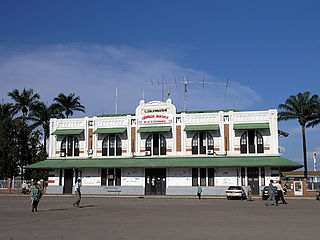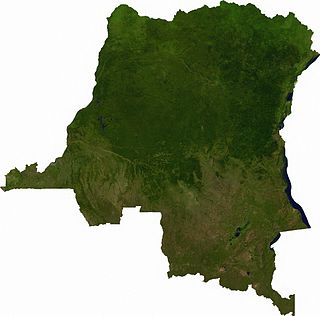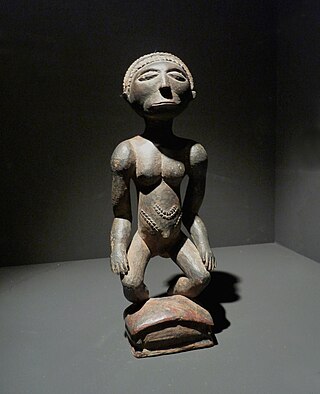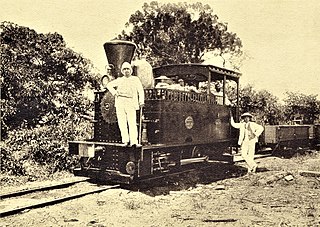
Ground transport in the Democratic Republic of the Congo (DRC) has always been difficult. The terrain and climate of the Congo Basin present serious barriers to road and rail construction, and the distances are enormous across this vast country. Furthermore, chronic economic mismanagement and internal conflict has led to serious under-investment over many years.

Kigoma is a city and lake port in Kigoma-Ujiji District in Tanzania, on the northeastern shores of Lake Tanganyika and close to the border with Burundi and The Democratic Republic of the Congo. It serves as the capital for the surrounding Kigoma Region and has a population of 232,388. The city is situated at an elevation of 775 metres (2,543 ft).

The Société Nationale des chemins de fer du Congo is the national railway company for the inland railways of the Democratic Republic of the Congo.

Articles related to the Democratic Republic of the Congo include:

Rail transport is provided in the Democratic Republic of the Congo by the Société Nationale des Chemins de Fer du Congo (SNCC), the Société commerciale des transports et des ports (SCTP) (previously Office National des Transports until 2011), and the Office des Chemins de fer des Ueles (CFU).

Lieutenant-general Baron Jules-Marie-Alphonse Jacques de Dixmude, often known as General Jacques, was a Belgian military figure of World War I and colonial advocate.
The Apostolic Vicariate of Tanganyika was a Catholic apostolic vicariate of the White Fathers missionary order at first centered on the mission of Karema in what is now Tanzania, that included parts of what are now Rwanda, Burundi, Democratic Republic of the Congo, Zambia and Malawi. As the number of missions, schools and converts grew, different regions became distinct vicariates covering portions of the original territory.

The Société Nationale des Chemins de Fer Zaïrois (SNCZ) was the state railway company in Zaire formed in 1974 by combining several privately owned railways. It suffered from lack of maintenance of the tracks and rolling stock, weak management, and external factors such as the Angolan Civil War and the collapse of the economy of Zaire under President Mobutu Sese Seko. Despite two projects funded by the World Bank, it had virtually ceased to function by the 1990s. It was replaced in 1995 by the short-lived private company SIZARAIL, which in turn was replaced by the present Société nationale des chemins de fer du Congo.
The Congo Arab war or Arab War was a colonial war fought between the Congo Free State and Arab-Swahili warlords associated with the Arab slave trade in the eastern regions of the Congo basin between 1892 and 1894.

Alexandre Delcommune was a Belgian officer of the armed Force Publique of the Congo Free State who undertook extensive explorations of the country during the early colonial period of the Congo Free State. He explored many of the navigable waterways of the Congo Basin, and led a major expedition to Katanga between 1890 and 1893.

The Holoholo also known as Kalanga are a Bantu ethnic group that inhabit the shores of central lake Tanganyika. The majority of them live near Kalemie city on Lake Tanganyika in Tanganyika Province of the Democratic Republic of the Congo, and on the opposite shore of the lake in Uvinza District of Kigoma Region in Tanzania.

Mpala is the location of an early Catholic mission in the Belgian Congo. A military station was established at Mpala on the shores of Lake Tanganyika in May 1883. It was transferred to the White Fathers missionaries in 1885. At one time it was hoped that it would form the nucleus of a Christian kingdom in the heart of Africa. However, after a military expedition had to be sent to protect the mission from destruction by local warlords in 1892, civil control returned to the Belgian colonial authorities. The first seminary in the Congo was established at Mpala, and later the mission played an important role in providing practical education to the people of the region.

Léopold Louis Joubert was a French soldier and lay missionary. He fought for the Papal States between 1860 and 1870 during the Italian unification, which he opposed. He later assisted the White Fathers missionaries in East Africa and played an important role in the suppression of the slave trade between 1885 and 1892. He married a local woman and settled by the shore of Lake Tanganyika, where he lived until his death at the age of eighty five.
Muhammad bin Khalfan bin Khamis al-Barwani, commonly known as Rumaliza, was an Arab trader of slaves and ivory, active in Central and East Africa in the last part of the nineteenth century. He was a member of the Arabian Barwani tribe. With the help of Tippu Tip he became Sultan of Ujiji. At one time he dominated the trade of Tanganyika, before being defeated by Belgian forces under Baron Francis Dhanis in January 1894.
Kibanga, formerly called Lavigerieville, is a settlement in the South Kivu province of the Democratic Republic of the Congo.
The Belgian Anti-Slavery Society was a 19th-century organization, with the goal of putting an end to the Arab slave trade in the African continent. The Belgian Anti-Slavery Society was founded in 1888, mainly by catholic intellectuals, led by count Hippolyte d'Ursel. The founders were inspired by the preaching of Charles Lavigerie, a French Cardinal, held at the Cathedral of St. Michael and St. Gudula in August 1888. By January 1889 the society counted 700 members and had a working capital of 300.000 francs at its disposal. The abolitionist ideology of the Anti-Slavery Society was, however, closely linked with imperialism. From 1890 to 1899 the Société antiesclavagiste de Belgique organized and funded four military expeditions, sent to fight the Arab/Zanzibari slavers of the eastern Congo Free State regions.

Frederik-Valdemar Olsen was a Danish soldier who became a general and commander in chief of the Belgian Congo Force Publique. He was born into a poor family, joined the Danish army, then in 1898 volunteered to serve in the Congo Free State. He rose quickly through the ranks, and in 1909–1910 played an important role in a stand-off with German and British forces disputing the eastern border of what was now the Belgian Congo. During World War I Olsen commanded a force that defended Northern Rhodesia against a German attack, then advanced from the south of Lake Kivu to take Tabora in what is now Tanzania. After the war he became commander of the Force Publique before retiring as a general in 1925. Olsen was then made general manager of the state-owned Congo River shipping line Unatra, later combined with railway lines to form Otraco. He retired from this position in 1947.

The Compagnie du chemin de fer du Congo supérieur aux Grands Lacs africains was a Belgian railway company established in 1902 in the Congo Free State, later the Belgian Congo, now the Democratic Republic of the Congo. It provided service in the eastern part of the colony south of Stanleyville (Kisangani) to serve the settlers and mining operations in Katanga. It operated a combination of river steamer service along the Lualaba River and railway links where the river was not navigable, including a link to Lake Tanganyika. In 1960 it became the Société congolaise des chemins de fer des Grands Lacs.
Odon Jadot was a Belgian railway engineer and administrator. He was responsible for building more than 1,650 kilometres (1,030 mi) of railroad in the Belgian Congo. The lines helped carry copper mined in the Katanga Province to the sea via the ports of Matadi in the Congo, Dilolo in Angola and Beira in Mozambique. They also supported troop movements during World War I (1914–1918) and World War II (1939–1045).

















